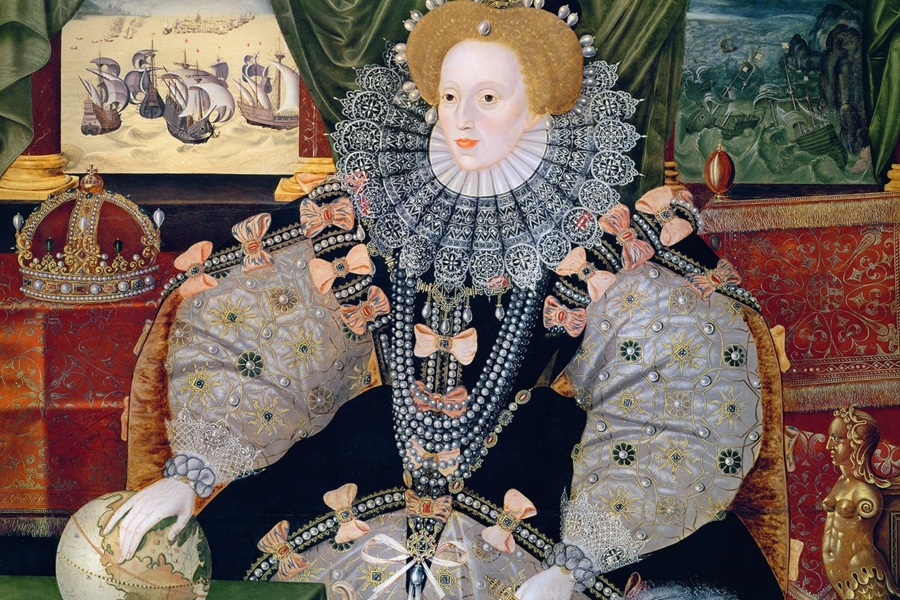Queen Elizabeth I
Lived: 1533-1603
Reigned: 1558-1603

Born: 1533
Place: Greenwich Palace
Reigned: 1558-1603
Coronation: 15 January 1559
Father: Henry VIII (1591-1547)
Mother: Anne Boleyn (c.1504-1536)
Spouse: Never Married
Children: None
Religion: Protestant
Died: 24 March 1603
Place: Richmond Palace
Buried: Westminster Abbey
Successor: James I
Queen Elizabeth I was the daughter of King Henry VIII and his second wife, Anne Boleyn. She became Queen at the death of her half-sister, Mary I, on 17 November 1558, and it was a remarkable triumph for the twenty-five year old woman. Her birth on 7 September 1533 had been one of the greatest disappointments of her father's life as he had moved mountains to marry Anne in the hope of having a son. When Elizabeth was two years old, her mother was accused of adultery and executed on Tower Green (19 May 1533), and from then onwards, Elizabeth was very much an outsider. Her father took very little personal interest in her and Mary (her older half-sister) was usually distant. Mary had suffered considerably at Anne Boleyn's hand, and was never able to forget that Elizabeth was her daughter. Things improved for Elizabeth when her cousin, Katherine Howard, married the King, but this happy state of affairs was not destined to last. Katherine was accused of adultery and beheaded in 1542. When Elizabeth's half-brother Edward VI (Henry's son by his third wife Jane Seymour) became King, Elizabeth only narrowly escaped execution herself because, through no fault of her own, she became embroiled in Thomas Seymour's traitorous plan to kidnap the King, and in Mary's reign, Elizabeth was even imprisoned in the Tower for suspected involvement in a Protestant rebellion against the Queen's marriage to Philip of Spain.
Elizabeth was a much loved monarch and known to her people as Good Queen Bess. She ruled England for almost forty five years, changing the country from a second rate power to one of the most powerful countries in the world. A conservative Protestant, she re-established the Church of England after the return to Roman Catholicism in the reign of Mary I, and successfully preserved religious peace in her country in a time when religious wars were being fought all over Europe. While her father, Henry VIII, is famous for marrying many times, Elizabeth is famous for never marrying at all. In the early years of her reign she faced immense pressure from her Privy Council and Parliament to marry, but for both personal and political reasons, she never yielded to that pressure and remained single. Elizabeth did come close to marrying twice, however. The first man she seriously contemplated marrying was her childhood friend, Robert Dudley, Earl of Leicester, and the second man was Francis, Duke of Alencon, brother to the King of France. Unlike her father, Elizabeth valued her hard-working ministers, and her relationship with William Cecil, Lord Burghley, is the longest working relationship between a sovereign and first minister in English history.
As Elizabeth was single and childless, the issue of the succession concerned a number of people, and opinion was divided over who should succeed. Many, especially Roman Catholics, believed that the best right lay with Mary, Queen of Scots, who was Henry VII's great granddaughter, while others favoured Arabella Stuart or the sons of Catherine Grey. Because Mary, Queen of Scots, was Roman Catholic, and Elizabeth's prisoner after her deposition in Scotland, many Roman Catholics plotted to kill Elizabeth and make Mary queen instead. One such man was Anthony Babington, and it was for involvement in his plot to free her, that Mary was executed at Fotheringay Castle in the February of 1587. The following year, Philip II of Spain sent his famous Armada against England, in the hope of deposing Elizabeth and bestowing the throne on his daughter, Isabel the Infanta. Determined to lead and inspire her people at this critical hour, Elizabeth left London for Tilbury, and there delivered a powerful speech to her soldiers. After a long battle in the English Channel, the English triumphed, and the defeat of the Spanish Armada is one of the most famous events in English history.
Elizabeth died on 24 March 1603 at Richmond Palace, London. Her funeral was held the following month, and witnesses reported that the grief of her subjects was so profound that when they saw her coffin being carried through the streets of London with the Queen's effigy upon it, there was such a crying and moaning that the like had never been known in history for the death of a sovereign.
The House of Tudor died with Elizabeth, and she was succeeded by King James VI of Scotland, son of Mary, Queen of Scots, who became James I

Main




















